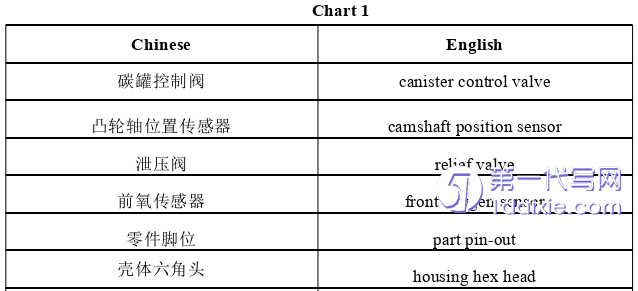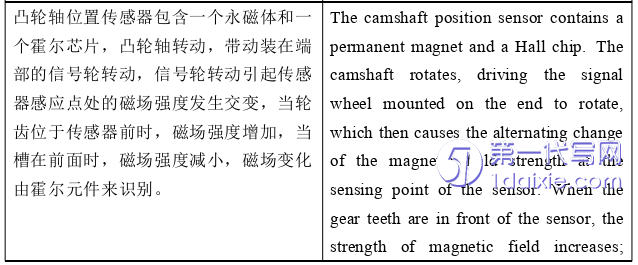本文是一篇英语论文,笔者在交际翻译理论关照下,探索有效的翻译策略和方法,能够使译文简洁、准确,符合目标语汽车行业语言规范和读者期待,发挥文本的交际功能。
1.Task Description
1.1 Background of the Project

Today’s world is experiencing great changes that have not been seen in a century.Anew round of scientific and technological revolution and industrial reform is developing indepth.Electrification,intellectualization and networking are accelerating the reconstructionof the old automobile industry,bringing new opportunity for the development of China'sautomobile industry.In 2021,China’s automobile market made a good start for theautomobile industry in the“14th Five-year Plan”and successfully kicked off a new roundof high-quality development.
Thanks to the recovery of the world economy,automobile consumption isregenerated.China’s automobile supply chain is relatively complete,and thecomprehensive quality of automobile products has also been greatly improved,making itpossible to provide competitive products for overseas consumers in time.It is said thatChina’s automobile export will usher in rapid growth and that the growth rate of China’sautomobile export is expected to be about 20%in 2022.In 2022,the automotive industrywill have great prospects under the support of government policies and the joint efforts ofenterprises.
The growth of China’s auto export is accompanied by the increasing overseasdemand for auto parts services.However,the market and product standards of China’sautomobile industry differ from the Western countries’,and there are certain differencesbetween their automobile technology and services,so it is necessary for an automobileexport company to provide corresponding supporting services.
1.2 Significance of the Project
From the perspective of the automobile industry,the high-quality English version ofautomobile maintenance manual in line with the reading habits of target language readerscan enhance customers’sense of trust,improve the international competitiveness ofChina’s automobile products,and expand automobile exports.
As for automobile companies,they could win reputation and trust from the importedcountries and customers,thus improving their products’competitiveness globally andincreasing their markets overseas by providing professional technical supports likewell-translated service manuals.
From the perspective of the customers,they can acquire maintenance manuals in linewith their reading habits which are exactly what customers really need.From the buyers’point of view,it ensures they know details of the vehicles bought without difficulties.Fromthe motor mechanic’s point of view,they can get technical supports by reading themaintenance manuals,even if they don’t know our country’s automobile technology wellenough.
Lastly,it is a chance for the translator who has participated in every steps of thetranslation activity to access to technical translation practice in society.Through thistranslation project,the translator makes improvements in translation skills,automotiveknowledge and application of the translation theory,laying a solid foundation for furthertranslation practice.
2.Translation Process
2.1 Pre-translation
This translation project is a translation practice of automobile technical text.The textcontains many technical specialized terms and automotive technical knowledge,and islong in length and diverse in form.Fraught with the above translation difficulties,thetranslator must do adequate preparation.The translator has read through and studied thesource text,collected a large amount of relevant data and parallel texts,made thoroughtranslation plan and prepared appropriate translation assistant tools to guarantee thetranslation work proceed smoothly.
2.1.1 Source Text Analysis
The source text is excerpted from the engine control system in Chapter five of XSUV Maintenance Manual,which is an original and professional Chinese automobiletechnical text and involves technologies of automobile usage and maintenance.Providedby the translator’s internship company authorized for the translator to translate,the sourcetext is a currently un-translated material with about 13000 words.It describes in detail theinstructions,precautions,troubleshooting methods and some maintenance technologies ofcomponents of X SUV engine control system.
As a typical scientific text,the source text has the general characteristics of scientificChinese:impersonal,formal in mode of speech,objective and accurate in statement,standard in language,undornated in stylistics,strict in logic and concentrated in technicalterms(Feng,1998:5).
2.2 While-translation
While translation,the translator has thoroughly comprehended the source text fromthe author’s intention,language style of the source text,automotive technologies and otheraspects.And the translator tried her best to make the expressions more in line with thetarget language.The translator has also recorded the difficulties met in the translation for further discussions and studies.
2.2.1 Comprehension and Expression
Comprehension and expression are two critical procedures in translation.Ahigh-quality translation activity requests that the translator endeavor to comprehend thesource text and well express the target text.
On the one hand,it is an essential work to thoroughly understand the source textwhile translation.Understanding the source text is a complex thinking process owned byhuman beings rather than a mechanical process.Proper understanding of the source textinvolves several thinking activities while translation.
First of all,the translator pondered over the source text to figure out the author’sintention.In this translation practice,the written of the automobile maintenance manual isto facilitate users to quickly understand the maintenance techniques of the vehicle andsolve the possibly encountered problems while using the product.By realizing the author’sintention,the translator can objectively and correctly grasp the content of the source text.Furthermore,studying the source text to understand the language style and characteristicsis the basis of further work.The automobile maintenance manual is objective in contentand clear in structure,so the translator has been keeping these features in mind whiletranslation to avoid substantial deviation of language style.Last but not least,theunderstanding of source text is inseparable from understanding related professionalknowledge.The translator has learned some integral automobile science to bettercomprehend the meanings between lines.
3.Peter Newmark’s Communicative Translation Theory................................11
3.1 Previous Studies on Communicative Translation Theory...........................11
3.2 Principles of Communicative Translation...............................13
4.Case Study under the Guidance of Communicative Translation Theory.........................15
4.1 Case Study of Words.................................15
4.1.1 Translation of Automotive Terminology...............................15
4.1.2 Translation of Polysemy........................................17
5.Conclusion..................................26
5.1 Findings....................................26
5.2 Limitations and Suggestions......................27
4.Case Study under the Guidance of CommunicativeTranslation Theory
4.1 Case Study of Words

Vocabulary translation is a prerequisite of translation work.According to thecommunicative translation,dealing with translation problems in the source text at lexicallevel must ensure the words to be translated precisely and technical.The translator foundout two typical types of words in the source text of this translation practice:automotiveterminology and polysemy.While translating these types of words,the translator mainlyadopted communicative translation as a strategy to meet target language readers’expectations.
4.1.1 Translation of Automotive Terminology
Automotive terminology refers to unified terms describing specific things inautomotive industry.These terms are so technical that they are beyond the ken of theaverage layman,and the translations of them are highly formalized.Different fromcommon vocabulary translation,the translations of terms can not to be reinvented(Fu,Wang,2014).Therefore,under normal circumstances,translators should consultdictionaries,seek guidance from specialists and refer to parallel texts to find out correcttranslations of automotive terms.Based on communicative translation theory,only whenthe translations are standards in the dictionaries or are the universal translations in theindustry,can the translations accurately convey the original information.
5.Conclusion
5.1 Findings
It is the translator’s first practical engagement in automotive technical texttranslation.In the translation of the text of this kind of subject,the translator has graspedthe language features of technical texts.What’s more,through adequate preparation,thetranslator has consulted relevant materials on automobile technology and machinery,andincreased a lot of professional knowledge of automobile industry,which equips thetranslator with a broader vision and more experience for later translation practice of similartexts.Due to the full participation in translation practice,the translator has also furthermastered the specific work in the translation practice of understanding,expression andrevision.
Newmark believes that translation is both science and art.On the one hand,somecontent has its regular translation in a certain field;on the other hand,there are varioustranslations of some contents(Wang,1982).The translator is required to possess strongbilingual ability and keen insight to select the appropriate translation.The translator shouldbe able to master rich vocabulary and various sentence patterns of native and foreignlanguages,constantly improve language level and consciously distinguish the differencesbetween English and Chinese expressions.
reference(omitted)
